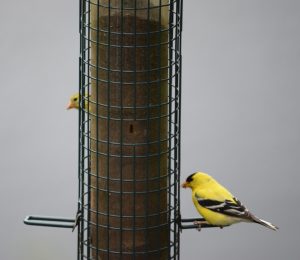
Lots of folks are asking why there are so few birds at their feeders this winter, as compared to last year. The answers to these types of questions are never as straightforward as we might think.
To start off, different numbers of birds are here from one winter to the next. A variety of factors contribute to how many birds spend their winters here, as well as whether or not they use feeders.
How many birds there are: Birds have more offspring some years than others, and offspring and adult survival vary from year to year, so overall population numbers fluctuate. For example, if food is abundant one year, there will likely be more young that year. The abundance of birds in that year can mean more food for their predators, so predator abundance might increase the next year, which will then reduce the numbers of birds during that year or the following year, and so on from year to year.
How many of these birds actually move south: Conditions farther north might permit birds to stay there for the winter or might force them to move south. For example, if there’s an abundance of natural seeds up north and temperatures aren’t too extreme, the birds might stay there for the winter (or longer into it). Snow depth and the presence or absence of a layer of ice crust on the snow can influence whether or not owls move south from one winter to the next.
Local food and weather conditions: Birds need more calories in extreme cold than they do in milder weather. As is true in the north, if there’s a lot of natural food available here, birds may rely less on feeders, especially in milder weather. When things get colder, we’ll likely see an increase in the numbers of birds using our feeders.
What’s going on at your feeder and other nearby feeders: Birds are smart. If one feeder is providing high-quality food that’s easy to access and another isn’t, they’ll choose the feeder that’s best for them. In addition to a good-quality feeding experience, birds need cover near the feeder to hide in if a predator comes by, and a feeder that doesn’t have a resident predator nearby (A Cooper’s Hawk – which eats birds – roosts in the cedars by our house some winters. When it does, we shut down our feeder, because keeping the feeder active turns it into a trap for the birds using it. Even if we didn’t, many of the birds would learn that there’s always a predator nearby and choose to eat elsewhere.)
I reached out to local naturalist and teacher, Drew Monkman, for his perspective on what’s happening this year. “The wild food crop this winter – seeds, nuts, berries, and cones – is abundant throughout the province. Northern finches like Pine Grosbeaks, Common Redpolls, and Pine Siskins have therefore remained in the boreal forest where they’re meeting all their food requirements. In other words, there has been no reason for them to migrate southward.”
If you’re missing Cardinals this year, Drew said that they “flock up in winter and sometimes will only visit a small number of feeders in a given area. If yours is not on their list, you might see few or no cardinals all winter.” In terms of American Goldfinches, he said, “I suspect that goldfinches are dining primarily on wild food this winter, hence their relative absence from feeders. These birds are also partially migratory, so it’s not uncommon for their numbers to drop in winter.”
So, it seems as though fewer birds have come south this winter due to an abundance of natural food, and it’s likely that many of those that are here are also relying on the abundant supply of natural food. In addition to that, we’ve had a lot of mild weather so far this winter. It will be interesting to see if feeder use increases when the temperatures drop in the upcoming weeks.
